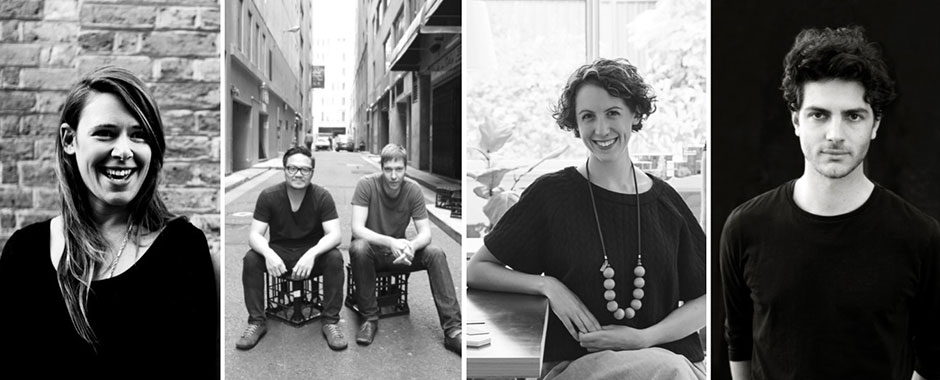Australia's Leading Range of Thermally Broken Aluminium Windows and Doors

Scale, collaboration and competitions were common topics of discussion surrounding this week’s Tuesday Night Talk Series. The talk, the first in a series called Look-See, brought together four young practices and the architects at their helm to discuss their unique approaches to architecture. Despite a lack of specific briefing of topics to discuss, each had overlapping experiences of their journey founding their own firms. The talks covered the process of finding work, which scale to work at, the double-edged sword of competitions, and the importance of collaboration.
Lucy Humphrey began the night with one of the more established practices, Archrival - a non-profit organisation she founded with Claire McCaughan in 2011. Their studio was established as an antidote to normal practise, a place for experimentation and challenges.
The practice began with an intention of never working for free, highlighting the amount of architectural energy spent and wasted in Expressions of Interest. However, as most architects would know, this was short lived, but it did generate a conversation of productive rivalry within architecture.
This set about the creation of a manifesto, which is ever changing in their business, adapting to their lessons learnt. The need to challenge standard practices, and retain the relevancy of architecture lead Archrival to behave more like a salon, architects and other creatives working competitively but collaboratively to produce great work across a variety of architectural and artistic mediums. The proof is definitely in the pudding, with Archrival now having worked on hundreds of collaborations, each project with a public, spatial and functional qualities walking the line between art and architecture.
Following Lucy’s impassioned talk, was Jennifer McMaster of TRIAS, the newest of the practices which is run by Jennifer along with Jonathon Donnelly and Casey Bryant. Despite being a relative new practice, Trias has leveraged architectural competitions, both locally and internationally, to build their practice into a small but thriving business.
Trias are testament to the ability of competitions to breed real world work, and Jennifer highlighted they way in which each of their competitions have lead to architectural projects, media exposure, and created connections both professionally and with clients. The time and effort placed into each of their renders belies the passion Trias have for each of their competitions, which are treated as if they were a real project. Each one is reworked following the competition to make sure their absolute best work is achieved, just as an author wouldn’t publish their first manuscript.
The practice’s motto of solid, simple and beautiful is evident throughout all of their projects, and the idea of ‘polite radicalism’ is one which resounds with architects and clients alike.
Tomek Archer begins with his story of returning to architecture after his music allowed him to travel the world and inspire his passion for design. Archer Office, established by Tomek, was named as one of 20 emerging practices to watch around the world in 2016. The practice is very focused on scale and began work with small, well designed pieces of furniture. Unlike Trias which leveraged their competitions for more work, Archer focused on furniture design and installations, like Poly at the Sherman Contemporary Art Foundation, which led to media exposure and clients returning for architectural projects.
However as the practice has grown in scale, so too have the projects. Though most projects still have a strong focus on furniture design, like the Wine Quarter, Archer have taken on larger projects like shopping centres and senior lifestyle villages, and remain consistent to their integrated design approach.
Lastly, Sean Choo of Up (Urban Possible) takes the stage, to discuss the ways in which he and Simon Fleet have approached their practice. Like Archer Office, UP had a focus on scale, aiming to never be constrained by the scale of a project too small or too large. This has led to a large amount of their work focusing on large scale multi-residential, in contrast to many of the other architects talking tonight.
UP believes in gaining the most amount of value from their architectural design and much of their work focuses on the front end of design, collaborating with larger firms for documentation and delivery of a project. Their attitude is that architecture is a negotiation and, like Trias, leveraged competitions for their earlier work. UP also accredit their collaboration with larger practices, to winning many larger projects - the stability of larger firms allowed them a sense of reliability which smaller, fresh practices often lack for larger tenders.
They believe this collaborative approach allows their practice to stay small and nimble, integrated thoroughly in the design practice, while drawing on the resources and experience of larger firms for more time intensive tasks like documentation. The rigour and time spent of design can be seen in the careful planning and site specific nature of each of their multi-residential projects
The end of night discussion led to some of the most interesting debate between the young architects, with each highlighting the difficulties in sorting a new practice and striving for work-life balance even if it isn’t always attainable. The message we are left with walking out of Tusculum is the necessity of collaboration in any practice, whether it be with other firms, consultants or a more productive competition.
Written by: Alexandra McRobert (NSW Event Correspondent for AWS)
Alexandra is a PhD Candidate at the University of Sydney and practising architectural graduate. Her research and work focuses on delivering affordable housing and prefabricated manufacturing techniques. Alexandra has also been involved in number of volunteer projects overseas, and spends a considerable amount of her spare time contemplating red wine and board games